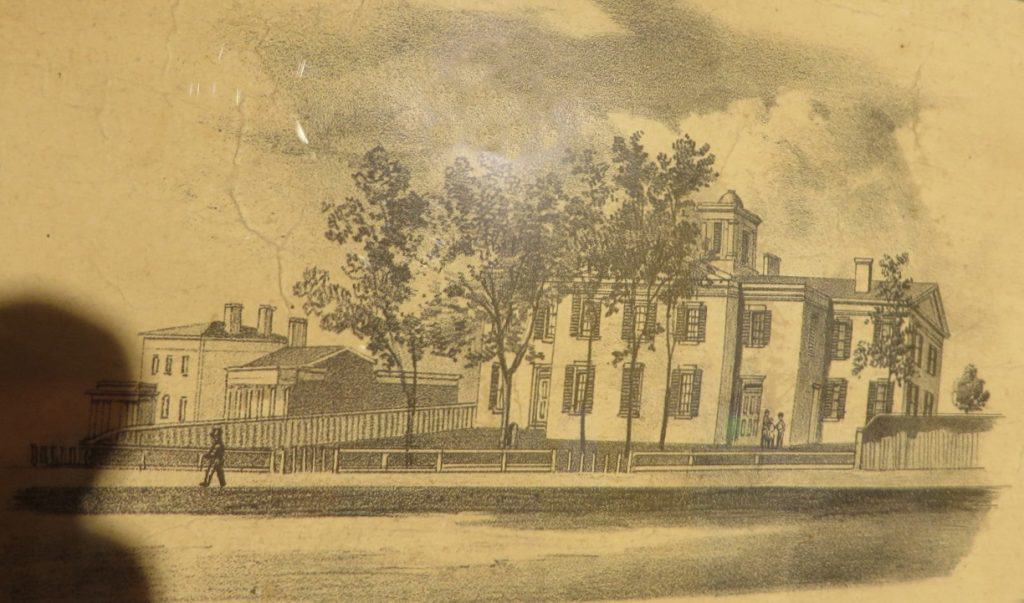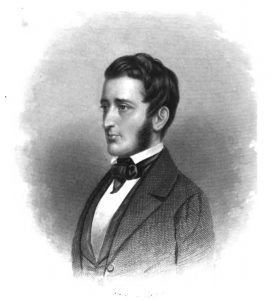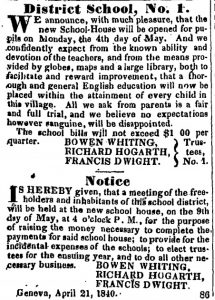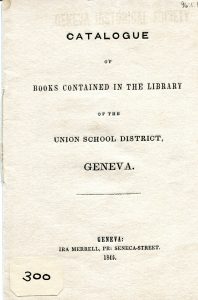Founding of the Geneva School District
By Anne Dealy, Director of Education and Public Information

The only image in the Geneva Historical Society collection of the Union School is on an 1856 map of the village.
The Geneva City School District can trace its birth to 1839, the year that the village’s Districts No. 1 and No. 19 merged to form the state’s first union school district. We saw in a previous blog post how public school districts were established early in Geneva’s history. By the 1830s, the community had a College, dozens of private schools, and two public schools for the basic instruction of children of all classes. Yet schooling in the antebellum period here and throughout New York was far from satisfactory. The unification of Geneva’s districts was part of a statewide movement in the mid-19th century to improve public schooling.
In 1839 New York had over 10,000 organized school districts educating about 529,000 children between 5 and 15 years. Most of these schools were small, one-room rural schools supervised by one to three locally elected trustees. The state Superintendent of Common Schools had nominal control over the system, but no practical authority over instruction or teacher quality. Elected volunteer inspectors judged school quality. They were to assess whether the state and community were getting their money’s worth.
An 1839 report on the condition of schools in the town of Seneca (which included Geneva until 1872) exposed some of the local failures of this system. The town inspectors reported in the newspaper that they were to visit each of 20 district schools at the beginning and end of each term (summer and winter). They managed this at 15 of the schools. The other five schools were visited once, twice or not at all. At the beginning of the term, inspectors were to “offer such suggestions to the teachers and pupils as seemed necessary to excite diligence and devotion to their respective duties.” The end-of-term inspection was to be a public examination of the pupils’ knowledge. That is, parents and the general public were invited to watch recitations and even question the students on their learning. The inspectors complained that aside from two districts, not more than six people attended these examinations; sometimes even the district trustees did not come. This local apathy, they wrote, was the main obstacle to school reform.
In addition, the inspectors argued that irregular attendance made getting a sound education impossible. The attendance rates of students rose and fell over the course of the term, running from 20 to 65 percent of the children living in the town at various times. Inconsistent instruction was another problem. Pay was poor, and teachers went in and out of the profession. They were often hired for only one term at a time, with men hired for the winter and women for the summer. This meant teachers often moved from school to school, even from town to town, and neither students nor teacher benefited from a regular relationship. Teachers also chose the textbooks and specific material to teach, so those too could change from one term to the next. The 1839 report pointed hopefully to the five districts that had resolved to hire a teacher for a full year, rather than the customary six months, as a sign of progress.

Lawyer Francis Dwight was active in creation of the Geneva School District before relocating to Albany to work for school reform.
The union of Geneva’s districts was prompted at the urging of local lawyer and school inspector Francis Dwight, who went on to work for school reform on the state level. He and other men of the village hoped that “a school [would] soon be established that the inhabitants of Geneva can inquire after without shame.” Since the establishment of the two district schools in 1822, the village population had increased by 250 percent. Geneva Academy had become Geneva College (now Hobart) in 1825, leaving the village without a public secondary school. In order to achieve their goals of educating the Republic’s future citizens, the reformers wanted a better organized and more efficient school system able to educate an expanding population. Creating one district school was the first step in that plan.

The new school district’s unified school house opened on Milton Street on May 4, 1840. The board still needed to figure out how to pay for it.
On April 24, 1839 the commissioners of Common Schools of the Town of Seneca annulled the old districts and formed the new District No 1. This accomplishment was tempered a few weeks later by the failure of the vote on $2000 to build a new, larger school house. Opponents believed “the tax is a certain evil, the school an uncertain good.” On May 28 the Geneva Courier ran an editorial supporting the new building. The editor wrote that the district finally had qualified teachers, but the current school “rooms will not accommodate more than fifty children, [and] are crowded with a throng of eighty or one hundred and twenty pupils. And even more than an equal number of children attend no school.” The tax was put to a second vote that night, and the following week the newspapers reported that the trustees were soliciting proposals from builders. The new school house for District No. 1 was completed the following year and the Union School opened May 4, 1840 on Milton Street. It contained four rooms and could accommodate 300 students. There were four teachers and the principal was Isaac Swift.
According to an 1862 history of the village, the school’s plan of organization became a model for others, drawing people from all over the state interested in unifying their districts under one school. The state’s education reformers believed that unifying multiple districts in larger villages would allow communities to build larger school houses, hire more and better teachers, purchase equipment and books, and deliver a better education to children. Larger districts would also be easier to inspect and supervise.
Five years in, the Courier had nothing but praise for the new system which had attracted a wide variety of families to it:
The increased respectability of the school by the patronage of the best educated families and by the employment of teachers that are amply qualified to give instruction in the best Academics; the thorough and extended acquisitions of the scholars, from the abodes of poverty as well as wealth, standing side by side in the same classes, displaying and cultivating their various gifts under the same intellectual training, and the kind moral influence that pervades the whole system and is breathed forth both upon the youth and the families to which they belong: these and similar circumstances have given peculiar prominence and value to the Geneva District School.

Beginning with the Union School, the district library had books both for students and the general public. Education of both children and adults was of concern to state school reformers.
Many Geneva families must have wanted this education for their children, for the new building was soon at capacity and had to be expanded with an east wing in 1842. Just ten years later, it was again overcrowded, although only 1,200 of the village’s 1,900 children attended it. In the summer of 1852 the Courier reported on a meeting to discuss the overcrowding. Citizens made it clear that a provision needed to be made for younger children living far from the Union School. Children as young as 4 had to walk a mile or more to the school during harsh and inclement weather (keep in mind there were no paved streets, sidewalks or snow plows). Soon a proposal was made to add three branch schools for younger children, add a west wing to the Union School for older students, and apply to the state to operate a classical department at the school for training young men for professions and college. This began the next period in the Geneva school system’s history, which we will continue with next time.
Related Posts
Segregated Schools in Geneva’s Past
